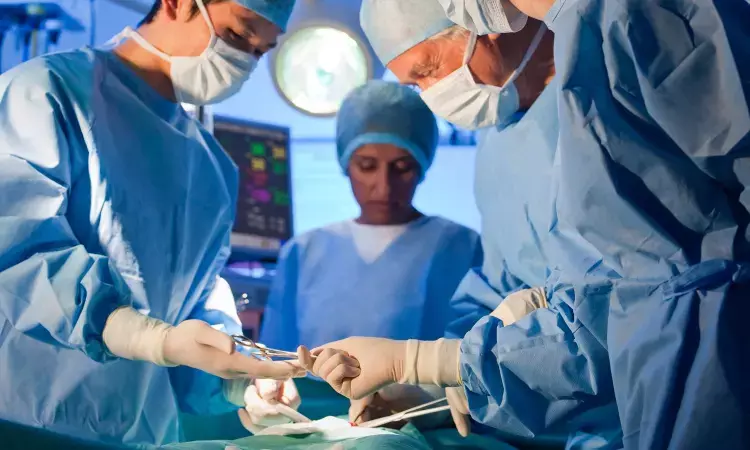- Home
- Medical news & Guidelines
- Anesthesiology
- Cardiology and CTVS
- Critical Care
- Dentistry
- Dermatology
- Diabetes and Endocrinology
- ENT
- Gastroenterology
- Medicine
- Nephrology
- Neurology
- Obstretics-Gynaecology
- Oncology
- Ophthalmology
- Orthopaedics
- Pediatrics-Neonatology
- Psychiatry
- Pulmonology
- Radiology
- Surgery
- Urology
- Laboratory Medicine
- Diet
- Nursing
- Paramedical
- Physiotherapy
- Health news
- Fact Check
- Bone Health Fact Check
- Brain Health Fact Check
- Cancer Related Fact Check
- Child Care Fact Check
- Dental and oral health fact check
- Diabetes and metabolic health fact check
- Diet and Nutrition Fact Check
- Eye and ENT Care Fact Check
- Fitness fact check
- Gut health fact check
- Heart health fact check
- Kidney health fact check
- Medical education fact check
- Men's health fact check
- Respiratory fact check
- Skin and hair care fact check
- Vaccine and Immunization fact check
- Women's health fact check
- AYUSH
- State News
- Andaman and Nicobar Islands
- Andhra Pradesh
- Arunachal Pradesh
- Assam
- Bihar
- Chandigarh
- Chattisgarh
- Dadra and Nagar Haveli
- Daman and Diu
- Delhi
- Goa
- Gujarat
- Haryana
- Himachal Pradesh
- Jammu & Kashmir
- Jharkhand
- Karnataka
- Kerala
- Ladakh
- Lakshadweep
- Madhya Pradesh
- Maharashtra
- Manipur
- Meghalaya
- Mizoram
- Nagaland
- Odisha
- Puducherry
- Punjab
- Rajasthan
- Sikkim
- Tamil Nadu
- Telangana
- Tripura
- Uttar Pradesh
- Uttrakhand
- West Bengal
- Medical Education
- Industry
Ultrasonographic stabilization, key parameter for determining follow-up length after unilateral pyeloplasty

Miami, FL: A recent study published in the Journal of Pediatric Urology has found ultrasonographic stabilization to be an appropriate and non-invasive parameter for determining the follow-up length after unilateral pyeloplasty. The study further states that it is an adequate timeframe for observing improvement or stabilization of hydronephrosis, identification of failed pyeloplasties, and performing any additional procedure required after the primary repair.
More than 1,500 pediatric pyeloplasties are being performed in the US per year but there is a lack of consensus on the adequate imaging modality and follow-up timing after surgery. To fill this knowledge gap, María Camila Suárez Arbeláez, Department of Urology, Nicklaus Children's Hospital, Miami, FL, and colleagues aimed to investigate if ultrasonographic stabilization in the grade of hydronephrosis after pyeloplasty is an adequate parameter for defining the optimal follow-up length after surgery and to detect failed procedures. They also analyzed clinical variables that could impact ultrasonographic stabilization.
For this purpose, the researchers conducted a retrospective chart review of patients who underwent pyeloplasty between 2012-2020. The patients who were aged ≤21 years old at the time of surgery, had ≥3 months of postoperative follow-up, had pre and postoperative renal ultrasounds, and had met the criteria for ultrasonographic stabilization after surgery were included.
Ultrasonographic stabilization was defined as 2 consecutive ultrasounds following pyeloplasty, a minimum of 1-month apart, with the same degree of hydronephrosis in accordance with the Society for Fetal Urology (SFU) grading system. Collection of data concerning clinical, surgical, and postoperative variables was done.
Based on the findings, the researchers reported the following:
· A total of 143 pyeloplasties met the inclusion criteria. The median age at surgery was 10.5 months with a median postoperative follow-up time of 29 months.
· Ultrasonographic stabilization was achieved in a mean time of 14.5 months post-operatively.
· Compared to the preoperative US SFU grade, at ultrasonographic stabilization 88.9% of patients had an improvement of ≥1 grade of hydronephrosis.
· There were 9 pyeloplasty failures that were diagnosed and surgically corrected in a median of 7.5 months after the initial surgery.
· No clinical or surgical variables were associated with time to achieve ultrasonographic stabilization.
The researchers wrote, "there is a great variation on the length of follow-up after pyeloplasty, ranging from 3 months to 7 years. In our cohort, the vast majority of patients got ultrasonographic stabilization and displayed improvement in their initial grade of hydronephrosis by 14.5 months after surgery."
"The timeframe in which surgical failures were diagnosed and corrected. There were no clinical or surgical variables associated with time to achieve stabilization."
"Similar results have been reported in the literature; however, most of them have evaluated as their main outcome resolution and not stabilization of hydronephrosis," they concluded.
Reference:
The study titled, "Ultrasonographic Stabilization of Hydronephrosis After Pyeloplasty: Key determinant of postoperative follow-up?," was published in the Journal of Pediatric Urology. DOI: https://doi.org/10.1016/j.jpurol.2022.08.003
Dr Kamal Kant Kohli-MBBS, DTCD- a chest specialist with more than 30 years of practice and a flair for writing clinical articles, Dr Kamal Kant Kohli joined Medical Dialogues as a Chief Editor of Medical News. Besides writing articles, as an editor, he proofreads and verifies all the medical content published on Medical Dialogues including those coming from journals, studies,medical conferences,guidelines etc. Email: drkohli@medicaldialogues.in. Contact no. 011-43720751


